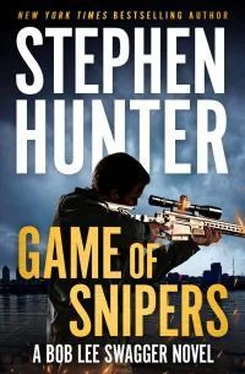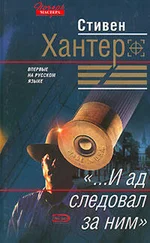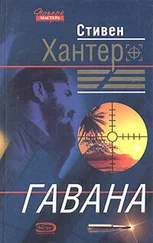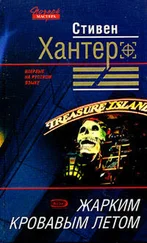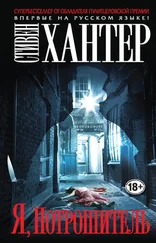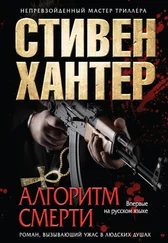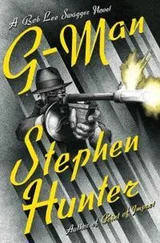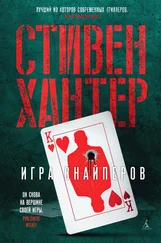“Janet,” said Chandler, “Nick’s right. We can’t go in all oriented to something. This is too important. That’s also why nobody on this team is political. We’re professional, we’re trying to solve a problem, that’s all it is.”
* * *
Like a guest star brought in for a flashy scene or two, she was indeed gone the next day, driven off by two junior agents to Salt Lake City and put on a late flight back to Baltimore. It really was the right decision, cruel as it may have seemed, because much had to be done and there wasn’t time to bring anybody new up to speed.
The various teams went to work. Nick spent a long, awkward time on the phone with the Director and an assistant attorney general, but somehow managed to survive. And, gradually, some sort of intelligence picture emerged.
Meanwhile, Swagger accompanied a crew of agents to the meadow where the drone pix showed that the shooting range was located. Fresh from the rain, it looked like Paradise Found — a sunny roll of lush land sparkling with droplets that had collected on the grass — a pure mile of open space. Above, of course, azure sky, clouds like melting vanilla, piercing late-summer sun, and, rimming all this glory, the Grand Tetons.
“He chained ’em here,” Swagger said, pointing to the four-by-four-inch post sunk in a wad of concrete and impervious to human influence, immobile even when subjected to the desperate energy of approaching death. The post bore grisly signs of struggle. It was smeared with the dark ochre of dried blood, and a few frags had blasted through the bound bodies and ripped shreds from its surface. One high miss left a perfect pucker drilled into the wood, at the bottom of which lay the expended and battered .338 bullet. Forensics would recover and analyze it.
“Mr. Swagger, we’ll also look for latent prints on this post. We’ll run chemical tests on the ground for blood, and if we find it, we can extract DNA.”
“That’s great,” he said. “You got corpse-sniffing dogs?”
“No, sir, but we have methane probes that are very efficient at locating buried cadavers, if we can just find some recently disturbed earth.”
“One more thing,” he said. He took out his iPhone and quickly prompted an app called My Altitude. Preset to southeast Wyoming’s general elevation as a baseline, it quickly placed this spot at 1,505 feet above sea level. He wanted to save that for future use.
“Now, the shooting platform?” he said. “This bird is so careful, and so committed to preparation, that he’ll have the distance down perfect.”
“Yes, sir.”
It took an hour.
“Got it!” someone cried, as all had moved a mile to the east and began to pick their way carefully through a scattering of elms and oaks, before it gave way to denser pines.
The men congregated at the site of the announcement, and indeed there it was, maybe seven feet up, a stout platform, well-braced and well-built, hammered into the vee of a giant tree. Branches had been clipped to allow for clear lines of fire to the faraway target, and a few wooden slats had been nailed into the trunk as steps to get up and down.
“Do I mess things up if I go up there?” Swagger asked.
“I don’t see how. There’s probably no prints on the bark, as it doesn’t take to prints. DNA? Maybe, but I’m guessing it’s more important to get the distance data than prove that a guy we know was here was here.”
Swagger was gloved and masked, and with a little help, managed to haul his old frame up to the platform. There, he saw what he couldn’t from below: a shooting bench, solid, built at the edge of the platform to provide stability for the rifle as the shooter oriented toward the target. That told Swagger that wherever Juba would be shooting from, he’d be sure he was solidly anchored.
From this position, Swagger looked out across the meadow. He had never made a shot at anywhere near that distance, only an eight hundred and fifty in Vietnam with his .308 — so long ago, it was impossible to recall details.
But a mile was different country. It was way the fuck out there, practically on a different planet, with winds that played on the bullet’s flight, humidity that thickened or thinned the air, a trajectory like a rainbow’s arc but without the colors, and time in flight of more than five seconds. Its execution demanded the rifle be placed as if embedded in rock, while, at the same time, administered with so delicate a touch that a heartbeat, a tremor, a microscopic twitch in the trigger push, or a moment of doubt or broken concentration, and the whole thing was off. Even with a 25× Schmidt & Bender, the finest optical system in the world, the human figure was but a dot. For its part, the post was impossible for him to pick out, even if the image was clear. It was just too small, too blended into the jagged background of trees. Through his binoculars, he saw nothing.
First move: the iPhone with the Altitude app. That drill revealed an altitude of 1,572, a difference of sixty-seven feet. He noted that figure as well.
“Okay, hand the thing up.”
The thing was a Tecna LH40 military-grade range finder, borrowed from the FBI sniper school and good out to twenty thousand yards. Oddly enough, it didn’t have the Star Wars look, with dials and buttons and all kinds of sci-fi stylistics. Instead, it resembled a slide projector from the ’60s, with which the family’s trip to Disneyland was documented for the neighbors. It took Swagger a bit of fiddling to get it set up on its tripod on the bench, then some more fiddling to get it on the target and focused, but finally he was ready.
Nothing.
“Can you get a guy to stand by the post. I can’t see it to take the reading,” he called.
He heard the team commander on the radio, and in a few seconds somebody — presumably, one of the men of the cadaver team that was looking in the area near the post for buried bodies — walked out and stood by the post. Swagger put his eye to the device, put the red dot on the tiny figure, and pushed the button to shoot a laser beam that far. The device would measure how quickly it bounced back and, in that way, solve the distance algorithm. He did it five times. The distance consistently turned out to be 1,847.5 yards.
He wrote the figure on the back of his hand in ballpoint under the altitude recordings, as insurance against a seventy-two-year-old memory.
“You get it?”
“Yeah, a little over a mile. Hell of a long way.”
It also might do, he figured, to find out from the household help what times of day the shooting took place, as those could be run against average wind speed, so he would also shoot when the speed of the wind was closest to the speed of the shot he’d come all this way to make. The position of the sun was another issue; he’d shoot when it most precisely matched the position it would be on the day of the shot.
So: he had direction, distance, the difference between the shooting site’s elevation and that of the target, the presence of water between himself and target, the wind speed, the position of the sun. All of these factors Neill could magically enter into a computer program and test for real-world matches, particularly at places, as yet to be determined, where likely targets would likely be. In that way, perhaps they’d unlock the secret and could deploy in time to prevent.
Anything else?
He racked his brain, came up with nothing. But of course Mr. Gold had yet to run his fine mind over the data. The Israeli was back in Washington, not being a necessary raid component.
“Mr. Swagger?”
“Yes.”
“Just heard from the cadaver team. The methane probe has turned up a batch of bodies. We have forensics on the way.”
“Got it. Can you have the guys do a fine-tooth-comb search of this area? Maybe there’s something here worth looking at.”
Читать дальше
